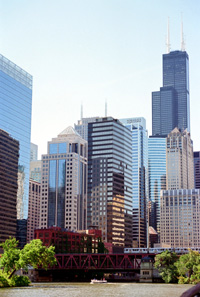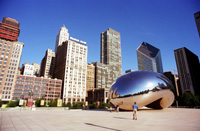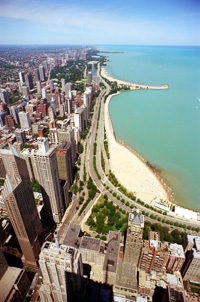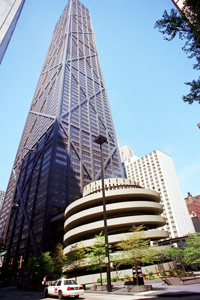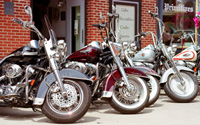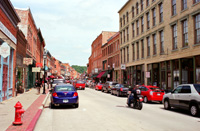Getting
Out There: |
Directory of all "Getting Out There" Articles> |
Chicago to the Mississippi by Peter Thody
|
| In the summer of 2007, Peter Thody and his wife Carole left their home in Leeds, England to embark on a 4,000-mile American road trip. Hotel bookings in Chicago and San Francisco established the bookends of the trip, a rental Jeep provided the means of getting from A to B, but the four weeks in between were left to write their own story. The first adventure took Thody to Illinois, where he discovered some odd examples of Americana: a 110-ton coffee bean, a 2,000-foot drill bit and a seemingly endless supply of artistically rusty, vintage farm implements. |
Just a few days into our American road trip last summer, my wife and I found ourselves at the Fort Cody Trading Post in North Platte, Nebraska. Toward the back of the establishment, beyond the fridge magnets and snow domes, past the dream catchers and brave-with-wolf wood carvings, we came across half a dozen glass cabinets containing more than 20,000 wooden pieces. Someone flicked a switch and the whole staggering, hand-carved and hand-painted scene burst into life.
We'd not heard of "Buffalo Bill's Wild West Show in Miniature" before visiting the Fort Cody Trading Post, and I don't suppose it's listed as one of America's great historical artefacts. But happening upon treasures like this is one of the rewards of unhurried travel, and invariably provides the warmest memories when, back home in England, we recollect the highlights of our trip.
It would be overstating things to say that you never know what's around the next corner. Elsewhere in Nebraska it'd be a cornfield, in Utah it'd be a rock, and in Nevada … well, in Nevada a corner would be a novelty. But rare were the days between leaving Chicago and arriving in San Francisco four weeks later that we failed to say something like: "Well, I'll be … so that's the world's third-largest cornfield" or, "You know … I'd never realised there was a Paper Clip Capital of Colorado."
The first leg: from Chicago to Galena
We'd been to Chicago before and loved the place -- everything
from the wooden buildings that back onto the Blue Line rail
track running into the city from O'Hare International Airport
to the inspirational architecture for which the city is renowned.
It's an easy city to walk, too, full of pedestrian areas and cycle paths, so we begin the day by making our way to Millennium Park, 24 acres of prime downtown real estate dedicated to open-air art, music and relaxation. For us, the clear-cut jewel in the park's crown is the Cloud Gate, a 110-ton, mirror-polished stainless steel sculpture in the shape of a coffee bean.
What hits us first is its scale (66 feet long, 33 feet high) and its wonderfully organic shape. Next are the amazing reflected views of the city, its convex curves capturing scenes far wider than the human eye could normally take in. Move closer still and it becomes an enormous fairground attraction, a three-dimensional hall of mirrors. And finally there's the 12-foot-high arch beneath it, inviting you to walk in and run your hand over the super-smooth surface. Impressive, beautiful, surprising and, at the same time, great fun.
A quick walk along the lakefront and next stop is North Pier Docks, where we board the Chicago Line's Architectural River Cruise (call ahead if you can -- every other sailing that day was fully booked). According to the literature, "If you only have two hours in Chicago this is how to spend it," and it would be difficult to argue.
It's not always easy to appreciate the city's architecture from its busy streets, but out on the river you get a far clearer view. You also get a fascinating commentary, pitched just right for people who don't know the first thing about architecture but know a nice building when they see one. We learn the significance of the Tribune Tower, the Wrigley Building, the Jewelers' Building and the record-breaking 110-storey Sears Tower. And we hear of the Chicago Spire, shaped like a drill bit, which by 2010 will spiral 2,000 feet into the sky (more than 500 feet higher than the Sears Tower).
Of all the city's buildings, though, the most iconic is the John Hancock Center with its superb views over Lake Michigan and the downtown area. Two floors are open to the public: The Hancock Observatory on the 94th floor, for which you'll stand in line for half an hour and pay a $10 entrance fee, and The Signature Lounge, which is two floors higher, free, has no queues and sells cold beer and great sandwiches.
Back down at ground level, we take an easy stroll in the sun along the Magnificent Mile, Chicago's most fashionable shopping district, and head back south to our hotel. Given that we're about to spend four weeks in unknown and very possibly spartan accommodation, we booked into the Palmer House Hilton, an opulent 25-storey hotel which in the 1920s was the largest hotel in the world.
With its huge, Versailles-style lobby, newly restored murals and extensive ceiling paintings, the hotel makes an impact from the moment you walk in. And if you're lucky, when you check in you'll be greeted with the words: "Hi! My name is Cedric and I'd like to offer you a complimentary upgrade to an executive suite." Which is what happens to us -- and which is why, instead of trying to squeeze in any of the other attractions we'd talked about visiting, we spend what's left of the afternoon in oversize dressing gowns, watching Court TV and calculating the markup on the minibar.
Resisting the urge to spend the evening luxuriating in lotions and potions, we make our way to Miller's Pub, just around the corner. This is a Chicago institution full of signed pictures of baseball players we'd never heard of, where the barman knows everyone's drinks and would have known ours, too, were we to have come back the next night.
The next morning, rested, refreshed and raring to go, we collect our Jeep Liberty and hit the road, heading west on Interstate 90. No-one would claim this to be the most picturesque stretch of interstate in the U.S. but it does the job, getting us away from Chicago's urban sprawl with the minimum of fuss. And to be honest, we don't even register its scenic failings: Here we are, driving across America, sharing the freeway with trucks bigger than our first house, listening to country and western music and looking forward to four weeks' worth of new places, new people and new experiences. Turn off the country and western and it'd be pretty much perfect.
Just west of Rockford, Illinois, the interstate is replaced by the much lovelier U.S. Highway 20, which carries us through a gently rolling countryside of green fields, red barns, white houses and antique garden implements. After a while you do begin to wonder where the local homeowners found so many restored buckets and milking stools. And then you arrive in Galena, a town whose sole raison d'être appears to be the sale of faux agricultural antiques to Harley-riding lawyers and dentists. Not that there's anything wrong with that.
After lunch, we drive back up the hill that brought us into town to visit General Ulysses S. Grant's one-time home, awarded to him by the grateful citizens of Galena at the end of the Civil War. Though Grant lived here only from 1865 to 1868 (when he moved into the White House), the house provides a fascinating insight into how modestly even the relatively affluent lived back then.
From its main street, Galena gives the impression of having been created in the late 1990s, in a late-1890s style. But walk down one of the side streets and you'll find it's a real place, with real people going about their everyday business. The contrast between the glass-and-steel skyscrapers of the third largest city in North America and the low-rise, brick-fronted shops and hotels of the largest city in Jo Daviess County couldn't be greater, but the reality is they're both just carrying out their business, just a century apart. And this, to us, is why Illinois is a microcosm of the USA as a whole. You might be slap bang in the middle of a 21st century metropolis one minute, but it doesn't take more than an hour or so to escape this and move back into an altogether slower way of life.
Peter Thody
December 14, 2007

